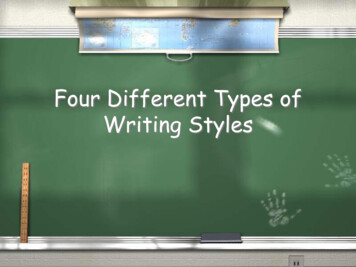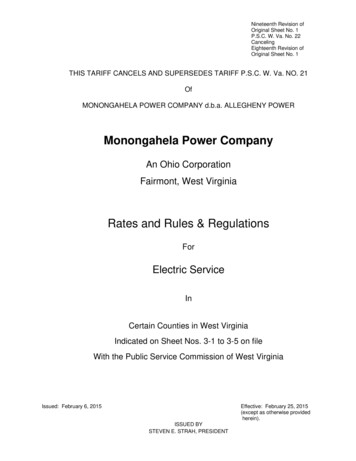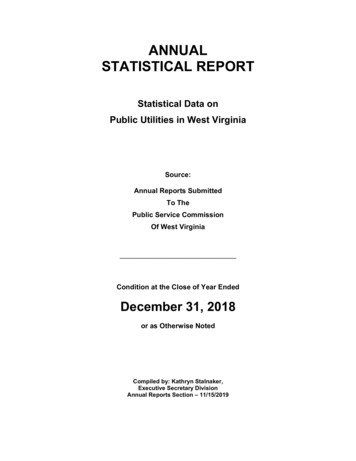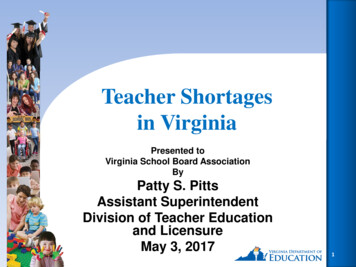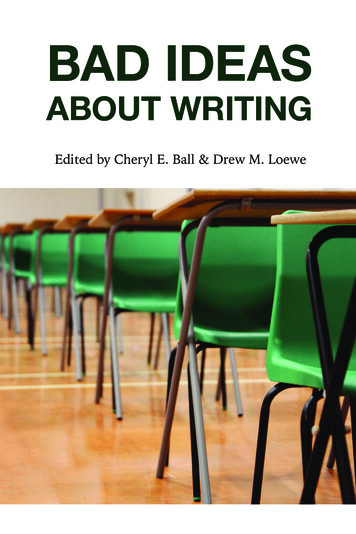
Transcription
BAD IDEASABOUT WRITINGEdited by Cheryl E. Ball & Drew M. Loewe
BAD IDEAS ABOUT WRITING
OPEN ACCESS TEXTBOOKSOpen Access Textbooks is a project created throughWest Virginia University with the goal of producing cost-effective and high quality products thatengage authors, faculty, and students. This project issupported by the Digital Publishing Institute and WestVirginia University Libraries.For more free books or to inquire about publishingyour own open-access book, visit our Open AccessTextbooks website at http://textbooks.lib.wvu.edu.
BAD IDEAS ABOUT WRITINGEdited by Cheryl E. Ball and Drew M. LoeweWest Virginia University LibrariesDigital Publishing InstituteMorgantown, WV
The Digital Publishing Institute believes in making work asopenly accessible as possible. Therefore, this work is licensedunder a Creative Commons Attribution 4.0 InternationalLicense. This license means you can re-use portions or allof this book in any way, as long as you cite the original inyour re-use. You do not need to ask for permission to do so,although it is always kind to let the authors know of yourre-use. To view a copy of this CC license, visit http://creativecommons.org/licenses/by/4.0/ or send a letter to CreativeCommons, PO Box 1866, Mountain View, CA 94042, USA.This book was set in Helvetica Neue and Iowan Old Style andwas first published in 2017 in the United States of Americaby WVU Libraries.The original cover image, “No Pressure Then,” is in thepublic domain, thanks to Pete, a Flickr Pro user.Library of Congress Cataloging-in-Publication DataforthcomingISBN-10: 0-9988820-0-3ISBN-13: 978-0-9988820-0-0
TABLE OF CONTENTSIntroductionCheryl E. Ball and Drew M. LoeweBAD IDEAS ABOUT WHAT GOOD WRITING ISRhetoric is Synonymous with Empty SpeechPatricia Roberts-MillerAmerica is Facing a Literacy CrisisJacob Babb1713First-Year Composition Prepares Students for Academic Writing 18Tyler BransonFirst-Year Composition Should be Skipped24You Can Learn to Write in General30Writing Knowledge Transfers Easily34Reading and Writing are not Connected38Reading is Not Essential to Writing Instruction44Paul G. CookElizabeth WardleEllen C. CarilloEllen C. CarilloJulie Myatt BargerBAD IDEAS ABOUT WHO GOOD WRITERS AREWriters are Mythical, Magical, and Damaged53You Need My Credentials to be a Writer60Only Geniuses can be Writers64Teri Holbrook and Melanie HundleyRonald Clark BrooksDustin Edwards and Enrique Paz
Some People are Just Born Good Writers71Failure is Not an Option76There is One Correct Way of Writing and Speaking82African American Language is not Good English88Official American English is Best93Writer’s Block Just Happens to People99Jill ParrottAllison D. CarrAnjali PattanayakJennifer M. CunninghamSteven AlvarezGeoffrey V. CarterStrong Writing and Writers Don’t Need Revision104The More Writing Process, the Better109Laura GiovanelliJimmy ButtsBAD IDEAS ABOUT STYLE, USAGE, AND GRAMMARStrunk and White Set the Standard117Good Writers Always Follow My Rules121Writers Must Develop a Strong, Original Voice126Leave Yourself Out of Your Writing131Response: Never Use “I”134The Passive Voice Should be Avoided139Teaching Grammar Improves Writing144Good Writers Must Know Grammatical Terminology150Grammar Should be Taught Separately as Rules to Learn155Laura LisabethMonique Dufour and Jennifer Ahern-DodsonPatrick ThomasRodrigo Joseph RodríguezKimberly N. ParkerCollin Gifford BrookePatricia A. DunnHannah J. RuleMuriel HarrisBAD IDEAS ABOUT WRITING TECHNIQUESFormal Outlines are Always UsefulKristin Milligan163
Students Should Learn About the Logical Fallacies168Logos is Synonymous with Logic174Daniel V. BommaritoNancy FoxBAD IDEAS ABOUT GENRESExcellent Academic Writing Must be Serious181Creative Writing is a Unique Category187Popular Culture is Killing Writing194Popular Culture is Only Useful as a Text for Criticism202The Five-Paragraph Essay is Rhetorically Sound209The Five-Paragraph Essay Transmits Knowledge214The Five-Paragraph Theme Teaches “Beyond the Test”220Research Starts with Answers226Research Starts with a Thesis Statement231The Traditional Research Paper is Best236Citing Sources is a Basic Skill Learned Early On242Plagiarism Deserves to be Punished247Michael TheuneCydney AlexisBronwyn T. WilliamsMark D. PepperQuentin ViereggeSusan Naomi Bernstein and Elizabeth LowryBruce Bowles, Jr.Alison C. WitteEmily A. WierszewskiAlexandria LockettSusanmarie HarringtonJennifer A. Mott-SmithBAD IDEAS ABOUT ASSESSING WRITINGGrading Has Always Made Writing Better255Rubrics Save Time and Make Grading Criteria Visible259Rubrics Oversimplify the Writing Process264When Responding to Student Writing, More is Better268Mitchell R. JamesAnne LeahyCrystal SandsMuriel Harris
Student Writing Must be Graded by the Teacher273Machines can Evaluate Writing Well278Plagiarism Detection Services are Money Well Spent287Christopher R. FriendChris M. Anson and Les PerelmanStephanie VieSAT Scores are Useful for Placing Students in Writing Courses 294Kristen di GennaroBAD IDEAS ABOUT WRITING AND DIGITAL TECHNOLOGYTexting Ruins Students’ Grammar Skills301Texting Ruins Literacy Skills308Gamification Makes Writing Fun315The More Digital Technology, the Better320Digital Natives and Digital Immigrants325Scott WarnockChristopher JusticeJoshua Daniel-WariyaGenesea M. Carter and Aurora MatzkePhill Michael AlexanderBAD IDEAS ABOUT WRITING TEACHERSYou’re Going to Need This for CollegeAndrew Hollinger333Dual-Enrollment Writing Classes Should Always be Pursued 338Caroline WilkinsonSecondary-School English Teachers Should Only be TaughtLiterature344Face-to-Face Courses are Superior to Online Courses351Anyone Can Teach an Online Writing Course356Anyone Can Teach Writing363Elizabethada A. WrightTiffany Bourelle and Andy BourelleBeth L. HewettSeth Kahn
BAD IDEAS ABOUT WRITING
INTRODUCTIONCheryl E. Ball and Drew M. LoeweBeginning in 1998, Edge.org has asked a diverse group of scholars, intellectuals, and artists the annual Edge Question, a question designed to spark arguments about provocative ideas to bepublished online and collected into print volumes intended for ageneral public audience. Edge Questions have included such questions as “What is your dangerous idea?,” “What have you changedyour mind about? Why?,” and the one that inspired this collection: “What scientific idea is ready for retirement?” That last question was the 2014 Edge Question, published in a book titled ThisIdea Must Die: Scientific Theories that are Blocking Progress. Drew firstsaw the book in a publisher’s exhibit at the 2015 Conference onCollege Composition and Communication, a big annual convention of writing teachers and scholars. After reading the book, especially in the context of an academic convention, Drew suggested onsocial media that the field of writing studies should publish its owncollective effort to name particularly unhelpful or backward ideasand argue directly to the public about them. Cheryl replied rightaway that she would be on board, and thus this project was born.This project is necessary because while scholars in writing studies (just as in any academic field) argue to and against one anotherin scholarly journals, books, and conference talks, those formsof knowledge-making don’t consistently find their way into thepublic’s understanding of writing. Yet “the public” in all its manifestations—teachers, students, parents, administrators, lawmakers, news media—are important to how writing is conceptualizedand taught. These publics deserve clearly articulated and well-researched arguments about what is not working, what must die, andwhat is blocking progress in current understandings of writing. Soour call for proposals sought contributions that provided a snapshot
2Bad Ideas About Writingof major myths about writing instruction—written by experts forthe educated public—that could collectively spark debate and haveus rethink our pieties and myths. This collection is an attempt bya varied and diverse group of writing scholar–teachers to translate our specialized knowledge and experiences about writing fora truly wide set of audiences, most of whom will never read thescholarly journals and books or attend conferences about this topicbecause of the closed nature of such publications and proceedings. In keeping with the public purpose of these writings, it wasimportant to us that it be published open-access. Because there areso few options for trade-like academic books that are open access,we decided—in consultation with the authors of this collection—to publish Bad Ideas About Writing as an open educational resourcethrough the Digital Publishing Institute, which Cheryl directs. BadIdeas will join other books in West Virginia University Library’snascent digital publishing project, where it will be supported bylibrarians for a long time to come.We intend this work to be less a bestiary of bad ideas aboutwriting than an effort to name bad ideas and suggest better ones.Some of those bad ideas are quite old, such as the archetype ofthe inspired genius author, the five-paragraph essay, or the abuseof adjunct writing teachers. Others are much newer, such ascomputerized essay scoring or gamification. Some ideas, such asthe supposed demise of literacy brought on by texting, are newerbad ideas but are really instances of older bad ideas about literacyalways being in a cycle of decline. Yet the same core questions suchas what is good writing, what makes a good writer, how should writingbe assessed, and the like persist across contexts, technologies, anderas. The project has its genesis in frustration, but what emerges ishope: hope for leaving aside bad ideas and thinking about writingin more productive, inclusive, and useful ways.The individual entries, which we came to dub as both opinionated encyclopedia entries and researched mini-manifestos, offersyntheses of relevant research and experience along with cross-references to other entries that take up related subjects. Instead ofthe typical trappings of academic citation styles (APA, MLA,Chicago, Oxford, etc.) that are specific to certain disciplines, weasked authors in the Bad Ideas collection to summarize the available research and present it in a way similar to how a newspaper,introductory textbook, or podcast might deliver such research—not through individual citations, but through a list of resourcesand further reading that would point readers to follow-up material.
Introduction3The authors of these entries are often published experts in thesefields, so searching for their other work at a library or online willproduce additional information on these topics. We have providedkeywords for each entry as well, which correspond to the academicterms that would appear in other peer-reviewed, published researchon these topics.The entries cohere around eight major categories of bad ideasabout writing that are tied to the production, circulation, culturaluse of, evaluation, and teaching of writing in multiple ways. Thecategories are bad ideas about: The features of good writing What makes good writers How grammar and style should be understood Which techniques or processes produce good writing Particular genres and occasions for writing How writing should be assessed How technology impacts writing Teachers of writingAlthough we have categories (and there are thematic clustersvisible within the larger categories), we encourage readers to readthe entries with and against each other, looking for productive overlaps and disagreements. For instance, there are at least three entrieson the five-paragraph essay—the genre perhaps most known by thevarious publics reading this book, and the most maligned by itswriters—and each entry takes a different perspective, disagreeingas needed where the research and the writer’s experience pertain.Without forcing a weak consensus or flattening out the individuality of the chapters, together they offer a practical, action-oriented group of rational manifestos for discontinuing unhelpfulor exclusionary ideas about a subject and activity that all have astake in. We hope that the collection is a conversation-starter, nota conversation-stopper, and we hope that it provides a catalog ofsupport for productive conversations about how and why to stopthe bad ideas about writing and start the good.
BAD IDEAS ABOUTWHAT GOOD WRITING IS
RHETORIC IS SYNONYMOUS WITHEMPTY SPEECHPatricia Roberts-MillerRecently, I was at a meeting of faculty whose research andteaching interests concerned issues of environmentalism. Acolleague from another department asked me what my area was.“Environmental rhetoric,” I replied. He looked slightly shockedand then commented, “Good environmentalism doesn’t have arhetoric.” I’m in a department of rhetoric, so I teach rhetoric, readscholarly pieces on rhetoric, and attend conferences on rhetoric.However, I often forget that other faculty members’ views on rhetoric might be different than mine.A popular view of rhetoric is that it is a straightforward modelof how communication should work: A person can speak the truthsimply by using words that refer to true things in the world. If shechooses not to use sentences filled with words that refer to truethings in the world, then she is engaged in rhetoric. Rhetoric, inthis view, is something you add on to sentences (such as metaphor) that decorates and obscures communication. If I say, “Thecat is on the mat,” I am using language correctly. However, if I say,“The elegant feline languishes mournfully on the expensive carpet,waiting impatiently for what he sees as his lazy servants to open acan of salmon,” then I have added rhetoric to the first sentence, orchosen rhetoric over clear communication.For many people, the simpler, plainer version of the sentence isnot just a stylistic choice, it’s a moral one. Many people believe thatthe addition of more complicated words obscures the meaning ofthe sentence. Rhetoric, to them, is something that hides the truth.If you look at the two sentences, though, you can see that the elaborated, supposedly more rhetorical one communicates quite clearly.In fact, it communicates more effectively and precisely than “The
8Bad Ideascat is on the mat.” It might, of course, be false—there might not besuch a cat; it might not be elegant; it might not be thinking muchof anything; it might be quite cheerful; it might not like salmon.But the same is true of the simpler sentence—there might not be acat; it might not be on a mat. Thus, linguistic simplicity and truthfulness aren’t necessarily connected, and linguistic complexity andtruthfulness aren’t necessarily opposed.Or, to put it another way, for a long time, philosophers oflanguage insisted that language works by sentences having propositional content—“the cat is on the mat”—which can be expressedin various ways. Rhetoric is what we layer onto the proposition.Or, as the old saying goes, “Rhetoric is clothing on the idea.” In anEdenic world, we would all wander around naked, and we wouldall simply and clearly speak our thoughts; rhetoric is something wemust have in this fallen world.People who believe that rhetoric hides meaning believethat we could return to Eden by using simple, plain, and rhetoric-free language. One of several underlying assumptions is thatit’s harder to lie in plain language, or that lies are more obviouswhen the language is less complicated. Therefore, we can trustplain language and should treat complicated language with suspicion. Oddly enough, this seemingly straightforward propositionisn’t true. In other words, this simple belief shows that an idea canbe untrue and persuasive at the same time. It is also interestingthat the master deceivers have generally relied on simple, yet false,claims. It’s quite likely that people believed their assertions wereclear and plain and, therefore, assumed that they must be true.The Edenic view isn’t a helpful way to think about rhetoric.It isn’t even how language works. While it’s true that the samething can be said in different ways, there is a way of saying thatthing without rhetoric. “The cat is on the mat” is still a style—thesimple style—with internal rhyming and prose rhythm. It’s alsostructurally the rhetorical figure of chiasmus—the sentence beginsand ends in an almost identical way. We can’t get away from rhetoric, but we can choose its kind.As in all interesting arguments, it’s a question of how we’redefining terms. And rhetoric has a variety of definitions. It was firstused in Platonic dialogues with very little precision. It comes fromthe Greek word for a person with a certain role in the AthenianAssembly (rhetor). It is believed that it was Plato who added the-ic later.He used rhetoric in terms of speech-making as opposed to
About What Good Writing Is9arguing in small groups. Plato wasn’t opposed to argumentation,and he wasn’t even opposed to some verbal sleight of hand. Afterall, Socrates—often read as a kind of spokesman for Plato’s views—relied heavily on some fairly dodgy logical moves in the dialogues.Plato’s point seems to be that speech-making isn’t a very usefulskill because making speeches to large groups (Athenian juriesmight have hundreds of people) is not very effective for gettingto the truth. It might be effective for getting others to accept thetruth one has already figured out (that seems to be the point thatSocrates is making in the dialogue Phaedrus), but, if you want tofind out what’s true, argue with another individual. Do not makea speech.Of course, Socrates makes a lot of speeches in Platonic dialogues.So, it is still murky whether or not Plato noticed the contradiction,was making a different point despite noticing the proposition, ordidn’t write the dialogues to get to the truth. In fact, Plato’s overall attitude toward rhetoric is murky, even though his school, theAcademy, did have rhetoric classes. They were taught by a mannamed Aristotle.On the other hand, Aristotle, who was a teacher of rhetoric, neither defined rhetoric as style nor as something you add tolanguage. He described it as a discipline and a skill that enablesyou to see the available means of persuasion. For Aristotle, rhetoric is about public speaking to large groups, and it is different fromphilosophy. So, he did share those two assumptions with Plato.But he didn’t agree with Plato about rhetoric not getting us to thetruth. He thought that it could get us to the truth, but that it couldalso be used to deceive. It depends on the motives of the personusing it.Aristotle loved syllogisms, and seems to have believed that allreasoning could be done through them. In philosophy, to get tothe truth, you try to begin with a universally valid major premise(e.g., all men are mortal). Then you have a more specific proposition related to that premise (e.g., Socrates is a man) that enablesyou to draw a conclusion (e.g., Socrates is mortal). But Aristotlesaid that this kind of reasoning doesn’t work in large assembliesfor two reasons. First, during a speech, people don’t have the timeto reason from universally valid major premises—if you’re arguingabout whether Philip of Macedon represents a threat, it’s uselessto try to find universally valid premises about tyrants or war orpeople from Macedon. You don’t have time. Second, the kind ofthings about which we make speeches—politics, ethics, military
10Bad Ideasstrategy, guilt or innocence, honor and dishonor—aren’t subjectto certainty. There are no universally valid major premises abouttyrants that will help us figure out what we need to do now andhere to assess Philip. We must rely on what is probably true.According to Aristotle, what you learn from rhetoric is howto approach political, ethical, and legal problems, how to comeup with an argument when you can’t be (or, at least, shouldn’tbe) certain that you’re right. You also learn how to assess otherpeople’s arguments. Aristotle, unlike many other philosophers,doesn’t present rhetoric as an inferior discipline to philosophy (hesays it’s a “counterpart”). It’s just different. It’s a pragmatic skillthat helps us in decision-making.Aristotle, being an astute observer, noticed that peopleargued about different things in similar ways. He came up with28 approaches, called “lines of argument” (they’re also sometimescalled “formal topoi,” which makes it seem as though they havelong dresses and white ties). If I am making a speech trying topersuade people to become more active in politics, I might arguefrom precedent (listed as #11 of his 28 lines), or argue that theconsequences of political activism are good (#13), or point outinconsistencies in the argument for political quietism (#22), andso on. Those different lines aren’t ornaments I hang on the proposition that people should be politically active; they are all differentways of thinking about the situation.Take, for instance, Aristotle’s first line of argument: consideration of the opposite, a strategy that might structure my entirecase. I might spend all my time trying to show that political activism is good because political quietism is bad. I might, however,make that just part of one speech, in which I move from how goodit is to be politically active to a moving description of the tragediesassociated with political quietism. Or, I might make it one paragraph, or one sentence. I might say, “Ask not what your country cando for you, but what you can do for your country.” In other words,the forms—such as consideration of the opposite—can be usedto structure a clause, sentence, paragraph, speech, or (in John F.Kennedy’s case) political philosophy. Rhetoric is a way of thinking.It is not just something added to a thought derived by other means.Does that mean that rhetoric is always good? Of course not.Rhetoric is a contingent, pragmatic, and generally (but not always)verbal way of approaching problems we face as members of communities. It is the cause as well as the consequence of thought. If wetend to think in binaries and divide everything into this versus that,
About What Good Writing Is11then we’ll probably be drawn to the rhetorical figures that dividethings into two. Continually presenting and interpreting issuesin that divided way will reinforce our sense that things really aredivided into two. We might then act in ways that divide things intotwo—we might believe that everyone is either an ally or an enemy,and thereby alienate neutral parties. Thinking and talking abouteveryone as ally or enemy might mean we are likely to end up in aworld in which people end up treating us in that manner. Rhetoricisn’t always good, and it isn’t always bad, but it’s rarely neutral.For instance, we might be tempted to use metaphors of disease,infection, or contamination for those groups that we don’t like.That might be a calculated decision to mislead an audience. Wemight not dislike the groups as vehemently as we project but westill perform for the audience to get votes, money, popularity, sales,sex, or something else. It is insincere. These types of people mightmake us feel unsettled and disgusted. They might even comeacross to us as dangerous. Thus, we call them slimy or a cancer onthe body politic. We proclaim that they spread ideas, weaken ourcommunity, and threaten our children. Those metaphors and thatrhetoric would feel accurate, and it would convey our meaning—itis not added on; it is not ornamentation. It is what we mean. Andit can hurt us as a community because it can mean that we theninterpret that group’s actions through a lens of disease, threat, anddanger. We can end up killing them or getting them killed becauseof the rhetoric we used. We can’t get away from rhetoric, but wecan choose the kind of rhetoric we use.Further ReadingFor further reading on rhetoric as more than “mere rhetoric,” see especially Wayne Booth’s Rhetoric of Rhetoric, whichdistinguishes between “rhetrickery” and rhetoric as an inclusivemethod of deliberation. Eugene Garver’s Aristotle’s Rhetoric: AnArt of Character is an elegant introduction to Aristotle, and DebraHawhee and Sharon Crowley’s Ancient Rhetorics for ContemporaryStudents, though a textbook, explains classical and current conceptions of rhetoric usefully.Keywordsconceptual metaphor, deliberative rhetoric, public argumentation,rhetorical topoi
12Bad IdeasAuthor BioPatricia Roberts-Miller is a professor in the Department ofRhetoric and Writing at the University of Texas at Austin, whereshe also directs the writing center. Her scholarly and teachinginterests include the history and theory of public argumentation—as she likes to put it, she’s a “scholar of train wrecks in publicdeliberation.” More about Trish can be found at patriciarobertsmiller.com.
About What Good Writing Is13AMERICA IS FACING A LITERACYCRISISJacob BabbIn a 1975 Newsweek article entitled “Why Johnny Can’t Write,”Merrill Sheils asserted, “Willy-nilly, the U.S. educational system isspawning a generation of semiliterates.” Sheils worried that technologies such as computer printouts and the conference call weredestroying Americans’ abilities to produce clear and concise prosein professional settings, warning that the decline of literacy meansthat they would soon find themselves back in Babel. Sheils offersa dire vision of late 20th-century Americans who were unwilling toembrace the highly structured rules of the English language and afailing education system that was shoving literacy over the precipice. Literacy, according to Sheils, was in crisis.The notion that literacy is in crisis is nothing new. Americanshave been asking why Johnny can’t write for a long time now. TheUnited States has fought against the perceived decline in literacysince the 19th century when higher education—indeed, educationin general—became more widely available to people who were notwealthy white men.It was during this era that higher education gradually shiftedaway from its narrow periphery that produced clergymen andlawyers. The Morrill Land-Grant Act of 1862 authorized states touse federal lands to build state-supported institutions that focusedon agriculture and technology. In response, many of the best universities in the country were established. Colleges and universitiesbegan to put greater emphasis on faculty research, moving awayfrom the more teaching-focused traditions of American highereducation. The emphasis on research continued to grow throughout the 20th century as universities worked with the federal government and private corporations to produce the kinds of advances in
14Bad Ideasscience that cured diseases, sent people to the moon, and obliterated large quantities of people with atomic weapons.As the purpose of higher education changed and more academicinstitutions were established, more people began going to college.The economic and educational backgrounds of new studentsbecame more varied. And with each change that was witnessedin students, technology, and media, academics and non-academicsalike bemoaned the decline of literacy.The perennial literacy crisis has been a significant contributor to the spread of composition instruction in American universities. First-year writing emerged in response to a perception amongfaculty members at colleges and universities as well as membersof the broader society outside academia that high schools werenot providing adequate instruction in writing and reading, so highschool graduates were underprepared for the rigorous demands ofacademic writing. At Harvard University, the faculty and administration decided that the crisis in student preparation required atemporary solution, a stopgap until high schools could improvethe quality of writing instruction and subsequently send studentsto college who did not struggle to write clear, coherent, and grammatically correct prose. That temporary solution in the 1880s wasEnglish A, a freshman composition course that instantly became amodel for other institutions across the country.The courses envisioned as temporary have since become astaple of American higher education. The reasons for the course’slasting power are complex, but literacy crises are the primary drivebehind the stabilization of first-year writing and the growth of writing instruction throughout undergraduate and graduate education.The academic field of writing studies owes its growth throughoutthe 20th century to public distress that literacy is failing.Blame for the collapse of literacy shifts from high-school teachers to technology, television, Internet, smart phones, laptops, andtablets—the same technology we often hope will rescue us fromilliteracy—to a lack of adequate funding for teacher education andthe institutions that provide literacy instruction. Since educationhas become more readily available to people of color and the lowermiddle and working classes, the demand for literacy instructionhas increased. Basic writing, a term coined by Mina Shaughnessythrough her work with community college students in New YorkCity in the 1970s, provided students with more time and instruction in reading and writing to prepare populations for college who,only decades earlier, would never have had the opportunity to
About What Good Writing Is15attend college. Writing instruction as a means of improving theliteracy of the diverse people living and working in the UnitedStates is a worthwhile endeavor.When framed as a response to the literacy crisis, writing instruction cannot help but carry a connotation of a desperate response toan epidemic. One of the chief beliefs associated with the myth ofthe literacy crisis is that writing instruction is basically a curricular Band-Aid, an inoculation against illiteracy that will soon go theway of smallpox and polio vaccines. Yet, well over a century afterits origination, composition remains a vital part of higher education, not just surviving but flourishing as writing instructors havedeveloped new approaches to writing instruction in light of theever-shiftin
Idea Must Die: Scientific Theories that are Blocking Progress. Drew first saw the book in a publisher’s exhibit at the 2015 Conference on College Composition and Communication, a big annual conven-tion of writing teachers and scholars. After reading the book, espe - cially in the context of a







